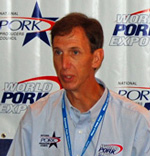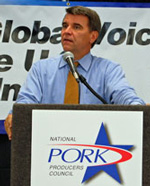Ethanol production as it relates to high feed costs was a major topic of discussion at the World Pork Expo in Des Moines last week, but pork producers understand that there are other factors impacting their input costs.
 “This is not specifically an ethanol problem,” said National Pork Producers Council president Bryan Black. “The world demand for grain, the total energy price crisis and shortages of grain across the world have led to this situation and we are not pointing the finger at any one particular one.”
“This is not specifically an ethanol problem,” said National Pork Producers Council president Bryan Black. “The world demand for grain, the total energy price crisis and shortages of grain across the world have led to this situation and we are not pointing the finger at any one particular one.”
The NPPC has created a brand new task force to look at new feed alternatives to help them deal with the rising cost of corn and soybean meal, which have been the primary source of feed for hogs.
 During a speech to pork producers at the expo, Deputy Agriculture Secretary Chuck Conner admitted that ethanol is a factor in the higher prices. “Ethanol is a new demand factor in the corn market, to the tune of about a third of our production going forward,” Conner said. “Fortunately, we did produce 13 billion bushels of corn and so despite large quantities going to ethanol, we actually did feed more corn to livestock than in previous years, so we managed to grow that market for both feed and ethanol.”
During a speech to pork producers at the expo, Deputy Agriculture Secretary Chuck Conner admitted that ethanol is a factor in the higher prices. “Ethanol is a new demand factor in the corn market, to the tune of about a third of our production going forward,” Conner said. “Fortunately, we did produce 13 billion bushels of corn and so despite large quantities going to ethanol, we actually did feed more corn to livestock than in previous years, so we managed to grow that market for both feed and ethanol.”
“We do recognize that there is some hurt out there in the livestock sector and with 70 percent of the cost of pork production going to feed, we know that you are first in line to get clipped,” said Conner. That is why USDA is buying pork for food assistance programs, which is helping the pork industry while at the same time helping the needy.
Conner said that USDA is also opening up some Conservation Reserve Program acreage to haying and grazing, which is primarily a direct benefit for cattle producers but it indirectly benefits hog farmers by increasing the amount of feed available to the livestock industry.

